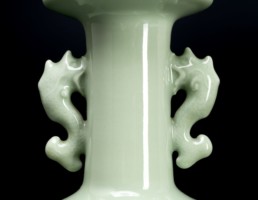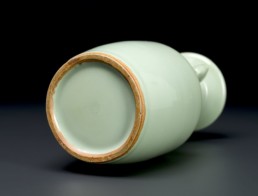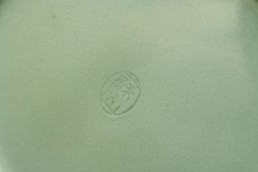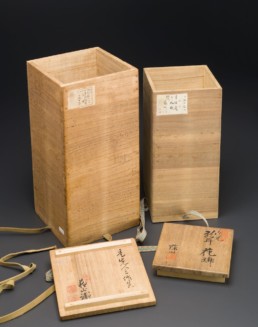Mallet Vase by Imperial Court Artist Suwa Sozan
Artist:Suwa SozanEra:MeijiPrice:SoldInquire:info@shirakuragallery.com
This extraordinary vase is a truly Japanese expression of a classical Chinese form. Fashioned after cylindrical Song Dynasty pieces that are thought to have been introduced in the 9th century from Syria, the handles are of Chinese origin and represent the mythical “Chiwen” (Shichihoko in Japanese). This deity, typically depicted with the body of a carp, the head of a tiger, and the scales of a dragon, is believed to be a bringer of rain and a protector against fire. The outer ring of the foot is unglazed showing the fine porcelain clay this piece is constructed from and the glazed center bears the seal of the Imperial Court Artist who fashioned this piece.
Suwa Sozan the first (1852—1922) was born in an area of what is known today as Ishikawa prefecture. After a short stint in the military he took up pottery design and painting under Touda Tokuji in 1873. From this point forward, he divided his time mainly between Kanazawa and Tokyo working at a number of kilns and research institutes. While in Tokyo, he made the acquaintance of famed conservator of Japanese art Ernest Francisco Fenollosa and the two became fast friends. In 1900 Sozan was invited to Kyoto to work at the Kinkozan kiln where he became noticed for his great skill in creating fine porcelain and celadon works. Several years later in 1907, he set up an independent porcelain and ceramics kiln on Gojo Zaka in Kyoto where he specialized in making a variety of porcelain pieces, most noted of which were his fine powdery-blue celadon pieces modeled after classic Chinese forms such as the vase featured here.
In 1917, Sozan was awarded the title of Teishitsu Gigei-in or Imperial Court Artist—what could be considered a precursor to the modern day Ningen Kokuho or National Living Treasure. His porcelains and meticulously detailed statuettes are held in the Imperial Collection, in the Ishikawa Prefectural Museum, in the Sumitomo Collection, and by a number of other museums and private collectors around the world.
In excellent antique condition, this piece is 4.7 inches in diameter at its widest point (12 cm) and stands 9.3 inches tall (23.5 cm). It bears the artist’s seal impressed into the base and comes with the original box (tomobako) which bears Sozan’s signature and seal on the lid. It also comes double boxed with an outer Sozan II certification box ensuring authenticity.
Additional Resources:






